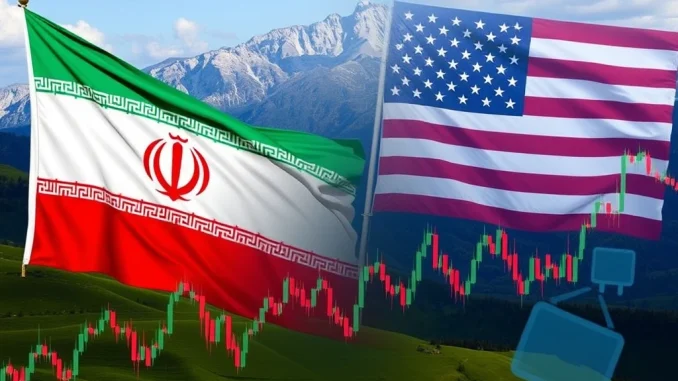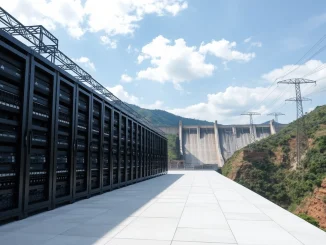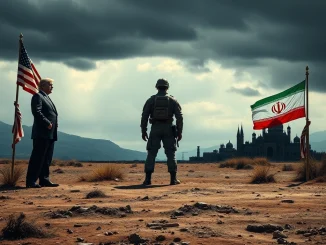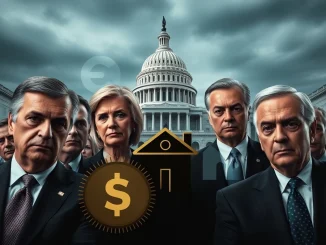
In the unpredictable world of global affairs, geopolitical events often send ripples across financial markets. For those navigating the cryptocurrency space, understanding these broader dynamics is crucial. A recent development underscores this reality: a stark warning from Iran regarding its military posture towards the United States. This escalation in Iran US conflict highlights growing Middle East tensions and raises questions about potential geopolitical impact crypto markets might face.
Understanding the Escalating Iran US Conflict
According to reports citing JinSe Finance and Jin10.com, a spokesperson for Iran’s military central command issued a significant statement. The core message was a direct warning to the United States: any further intervention in the ongoing regional conflict would be met with decisive action. The Iranian official reportedly stated that increased US involvement has broadened the scope of targets deemed legitimate for Iranian military force.
This statement is more than just rhetoric; it signals a potentially dangerous phase in already fraught relations. To grasp the gravity, consider these points:
- Direct Warning: The language used is unambiguous, threatening direct military action against US assets or personnel.
- Expanded Targets: This suggests that locations or forces previously considered off-limits might now be on Iran’s list.
- Context of Conflict: While the report doesn’t specify the exact conflict, it’s widely understood to be related to the broader instability in the Middle East, particularly in the wake of recent events involving Israel and Gaza, and the actions of various regional proxy groups.
- US Involvement: The US has increased its military presence and support in the region, which Iran views as direct interference.
The history between Iran and the United States is long and complex, marked by decades of mistrust, sanctions, and proxy confrontations. Events like the 1979 Iranian Revolution, the hostage crisis, ongoing disputes over Iran’s nuclear program, and regional influence struggles have all contributed to a volatile relationship. This latest warning adds another layer of tension, potentially bringing the two nations closer to direct confrontation than they have been in years.
Why Geopolitical Risk Matters for Markets
Geopolitical risk refers to the risk that political decisions, events, or instability in one country or region could negatively affect the political and economic stability of other countries. It’s a significant factor for global markets because it introduces uncertainty. Uncertainty can lead to:
- Reduced investor confidence.
- Disruption of supply chains.
- Changes in commodity prices (especially oil).
- Shifts in capital flows as investors seek safer assets.
- Increased market volatility.
Historically, major geopolitical flashpoints have triggered sharp reactions in traditional markets. Conflicts, terrorist attacks, or significant political shifts can cause stock markets to drop, push up the price of safe-haven assets like gold or government bonds, and dramatically impact currencies and energy markets.
Exploring the Geopolitical Impact on Crypto
The connection between geopolitical impact crypto markets experience is a topic of ongoing debate. When Bitcoin first emerged, some proponents argued it could serve as a ‘digital gold’ – a safe haven asset uncorrelated with traditional markets and insulated from political control. The reality has proven more complex.
Here’s how escalating tensions like the Iran US conflict could potentially affect the crypto market:
1. Increased Volatility: Like traditional risk assets, cryptocurrencies can experience significant price swings during times of global uncertainty. Fear can lead to sell-offs, as investors liquidate assets to reduce exposure or cover losses elsewhere. Conversely, a narrative of crypto as a hedge against traditional system instability could theoretically increase demand, though this effect is less consistent than for traditional safe havens.
2. Investor Sentiment: Negative headlines about potential conflicts or economic instability can dampen overall investor enthusiasm across all asset classes, including crypto. The risk-off sentiment often sees investors retreat from more speculative assets.
3. Capital Flows: In extreme scenarios, capital might flow into or out of regions affected by conflict. While crypto could potentially be used to move value across borders, increased scrutiny and potential sanctions related to conflicts could also pose risks for digital asset usage.
4. Macroeconomic Effects: Geopolitical events can impact inflation, interest rates, and economic growth globally. These macroeconomic factors have shown a significant correlation with crypto market movements, particularly over the past few years as crypto has become more integrated into the broader financial system.
5. Sanctions and Regulations: Escalating conflicts can lead to new sanctions. While challenging to enforce perfectly, sanctions targeting specific entities or regions could potentially impact crypto usage or exchanges operating in those areas, or those dealing with sanctioned parties.
Consider the market reactions during the initial stages of the Russia-Ukraine conflict in early 2022. Bitcoin and other cryptocurrencies experienced significant downturns, largely moving in tandem with traditional risk assets like tech stocks, rather than acting as a safe haven.
Middle East Tensions: A Constant Factor
The Middle East has long been a region of significant geopolitical importance, primarily due to its vast energy resources and complex political landscape. Middle East tensions have historically been a major driver of oil prices and a source of global instability. For the crypto market, which exists within this global economic framework, events in the region are not isolated incidents.
The current environment, with the Iran US conflict potentially escalating due to regional dynamics, adds a layer of uncertainty that financial markets must digest. While the direct operational impact on decentralized networks might be minimal, the indirect effects through investor behavior, macroeconomic shifts, and potential regulatory responses are real.
Navigating Uncertainty: A Crypto Investor Strategy
Given the potential for increased market volatility stemming from rising geopolitical risks like the Iran US conflict, what should a crypto investor strategy look like?
Here are some considerations:
- Stay Informed: Pay attention to global news, not just crypto-specific headlines. Geopolitical events can be leading indicators of potential market shifts.
- Assess Your Risk Tolerance: Understand that increased tension can lead to unpredictable market movements. Ensure your portfolio allocation aligns with your comfort level for risk.
- Diversification: While diversification within crypto is important, also consider your overall asset allocation. How does crypto fit into your total investment picture during times of uncertainty?
- Long-Term Perspective: For long-term investors, short-term geopolitical volatility might be viewed as noise. Focus on the fundamental potential of the technology rather than reacting impulsively to daily news cycles.
- Avoid Leverage in Volatile Times: High leverage can be wiped out quickly by sudden price swings driven by unexpected news.
- Consider Stablecoins: In periods of extreme volatility, some investors may increase their holdings in stablecoins to preserve capital, though stablecoins carry their own risks (e.g., counterparty risk depending on the stablecoin).
It’s important to recognize that there is no single guaranteed ‘safe’ approach during times of geopolitical stress. The crypto market is still relatively young and its reactions to global events are still being observed and understood.
Challenges and Nuances
Predicting the exact geopolitical impact crypto markets will experience is challenging. The market is influenced by a multitude of factors, and geopolitical risk is just one, albeit a significant one. Other factors include regulatory developments, technological advancements, institutional adoption, and overall market sentiment driven by internal crypto narratives.
Furthermore, the decentralized nature of many cryptocurrencies means they are not directly tied to the economic performance or political stability of any single nation in the way a national currency or a company’s stock is. However, the exchanges where they are traded, the companies building infrastructure, and the investors holding the assets are all subject to national laws and global events.
The narrative of crypto as a safe haven remains largely unproven during major global crises. While some see it as an alternative outside the control of governments and central banks, its correlation with traditional risk assets during recent downturns suggests it’s currently perceived more as a growth asset than a defensive one by the majority of mainstream investors.
Conclusion: Staying Vigilant in a Connected World
The warning from Iran regarding its military response to US involvement is a stark reminder of the interconnectedness of global affairs. Rising Middle East tensions contribute to overall geopolitical risk, a factor that no investor, including those in the crypto space, can afford to ignore. While the direct impact on decentralized networks may be limited, the indirect effects on market volatility and investor sentiment are significant.
For those developing a robust crypto investor strategy, staying informed about global events like the escalating Iran US conflict is essential. It’s not just about understanding potential price movements, but about appreciating the complex web of factors that influence financial markets in the 21st century. As tensions flare, vigilance and a well-considered approach remain your best tools in navigating the uncertain landscape.
Ultimately, while the headlines focus on military posturing, the economic and financial consequences resonate globally, underscoring the need for a holistic view when investing in any asset class, including digital assets.



